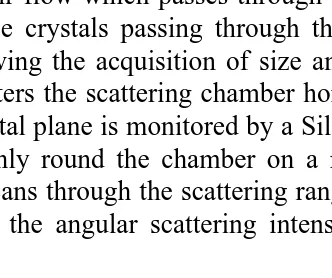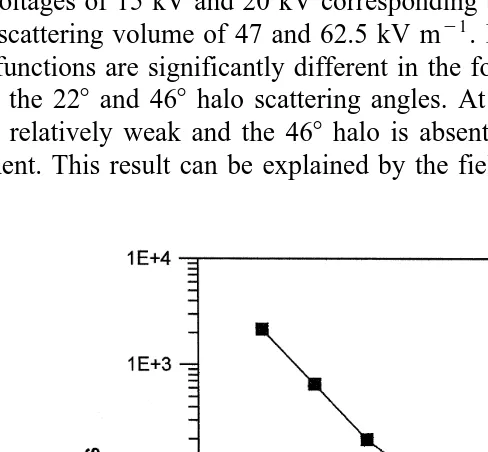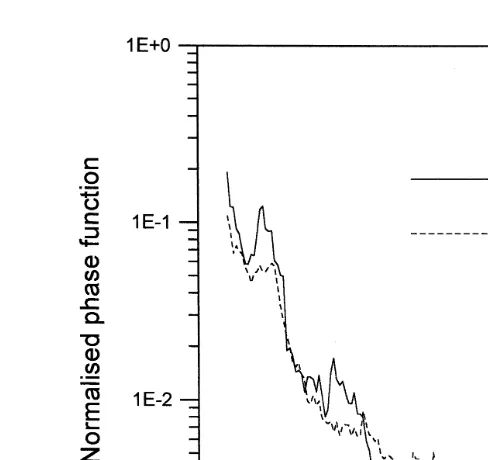The electric field alignment of ice crystals
in thunderstorms
C.P.R. Saunders
), J.S. Rimmer
Physics Department, UniÕersity of Manchester Institute of Science and Technology, SackÕille Street,
Manchester M60 1QD, UK
Abstract
The re-orientation of ice crystals in cirrus anvils following a lightning stroke is often visible from the ground with a sudden change in cloud brightness. Vonnegut suggested that this effect was due to electric field orientated ice crystals relaxing their orientation upon the removal of the field. Laboratory measurements of the electric field strength required to orientate ice crystals typical of those in thunderstorm anvils have now been made. The particular distribution of visible laser light scattered by a cloud of ice crystals orientated in an electric field is used to identify the types of ice crystal present.q1999 Elsevier Science B.V. All rights reserved.
Keywords: Ice crystal; Electric field; Thunderstorm
1. Introduction
Ž .
Vonnegut 1965 suggested that the orientation of ice crystals falling in thunderstorm anvil regions would be affected by the local electric field and that following a lightning discharge the rapid re-orientation of the reflecting crystals would lead to a change in
Ž .
cloud brightness visible from the ground. Mendez 1969 studied the polarization of light scattered by anvil crystals in New Mexico thunderstorms and noted a rapid change
Ž .
at the time of a lightning stroke. Hendry and McCormick 1976 used a polarization diversity radar and reported abrupt changes in orientation of ice particles in the anvil
Ž .
regions associated with lightning discharges. Shao and Krehbiel 1996 used a dual
) C orresponding author. T el.: q44-161-200-3909; fax: q44-161-200-3941; e-m ail: [email protected]
0169-8095r99r$ - see front matterq1999 Elsevier Science B.V. All rights reserved.
Ž .
( ) C.P.R. Saunders, J.S. RimmerrAtmospheric Research 51 1999 337–343
338
circular-polarization radar in a remote study of storm electrification and are currently using the information to map out the electrical alignment directions in storms.
Evidently, electric fields in the electrified regions of thunderstorms are sufficient to orientate ice crystals and the release of electric tension following a lightning stroke leads to the observation of a rapid re-orientation of the crystals. The detection and identifica-tion of ice crystals in clouds by remote means such as radar and lidar is influenced by the orientation of the ice crystals so that a knowledge of the critical field required to orientate crystals will be a useful tool both as a help in identifying the types of ice crystals in the cloud and as a remote indication of the strength of the electric field present before lightning.
The anvil regions of thunderstorms contain ice crystals which extend in size to a few
Ž .
hundred micrometres. Arnott et al. 1994 measured crystal sizes in cirrus using a
Ž .
replicator designed by Hallett 1976 and confirmed this size range but were surprised to find a crystal distribution with a maximum crystal size below 50 mm; they concluded that the optical scattering properties of such clouds are influenced significantly by these smaller crystal sizes. Vonnegut’s suggestion was that the reflection of light from the faces of crystals produces the observed change of cloud brightness following lightning, and this will be the dominant cause of the visual observations. However, the laboratory technique makes use of the refraction of light by ice crystals in order to determine their orientation in an electric field. The ice crystals scatter visible radiation in all directions and also act as prisms and so refract light most efficiently at angles close to their angle of minimum deviation. For light entering a prism face of a hexagonal plate ice crystal and leaving via another prism face, the ice crystal acts like a 608 prism for which the angle of minimum deviation is 228. In the atmosphere, horizontally orientated plate crystals cause sun-dogs visible at 228 on either side of the sun when fairly low in the sky, while a random orientation of ice crystal plates or columns produces the complete 228halo around the sun. A randomly orientated array of thick plate or columnar crystals produces a 468halo when light enters a basal face and leaves through a prism face with the crystal acting like a 908prism; occasionally 468sun dogs are visible indicating the presence of horizontally orientated columnar crystals. In this work a laboratory study of the scattering properties of ice crystals has been adapted to permit study of the orientational effect of an electric field.
2. Experimental details
Fig. 1. The cold room containing the ice crystal cloud chamber and the light scattering chamber.
Within the cloud chamber is a cylindrical chamber through which the cloud is drawn down by an air flow which passes through the imaging optics of a PMS 2 D grey scale probe. The ice crystals passing through the scattering chamber are thus continuously sampled allowing the acquisition of size and concentration data. A He–Ne laser beam
Ž0.63mm enters the scattering chamber horizontally, Fig. 2, and the radiation scattered.
in the horizontal plane is monitored by a Silicon–Germanium photodiode detector which moves smoothly round the chamber on a motor driven rotating table under computer control and scans through the scattering range 108to 1708. The phase function, which is a measure of the angular scattering intensity, is determined from the scattering data
( ) C.P.R. Saunders, J.S. RimmerrAtmospheric Research 51 1999 337–343
340
Ž .
following the method outlined by Sassen and Liou 1979 and described by Rimmer and
Ž .
Saunders 1997 .
In order to determine the effect of a vertical electric field on the crystal orientation, an electric field plate is located 32 cm above the floor of the metal scattering chamber. The electric field plate can be raised to a potential up to 20 kV to provide a non-uniform field in the chamber. However, in the small active light-scattering volume in the centre of the chamber, the field is vertical with a maximum value in the region of 62.5 kV my1
Ž
which is of the order of typical breakdown electric field strengths in thunderstorms 100
y1. Ž .
kV m according to Winn et al. 1981 .
3. Results
Fig. 3 shows the ice crystal size distribution for the cloud used in our experiment. The cloud chamber temperature varied fromy8.58C at the top toy208C at the bottom giving a mixture of columnar and plate type ice crystals. In Fig. 4 we show the phase
Ž .
functions normalised intensity distribution as a function of angle of scatter for field plate voltages of 15 kV and 20 kV corresponding to vertical electric fields in the centre of the scattering volume of 47 and 62.5 kV my1. It is apparent from the figure that the phase functions are significantly different in the forward scattering regions, particularly around the 228 and 468 halo scattering angles. At field strengths up to 15 kV, the 228
halo is relatively weak and the 468halo is absent, however at 20 kV, both haloes are prominent. This result can be explained by the field-induced charges in the ice crystals
Fig. 4. Scattering phase functions for field plate voltages of 15 kV and 20 kV.
causing them to align their major axes with the field. Orientated columns, which become
Ž .
orientated vertically with the longer axis c-axis parallel to the vertical electric field, will lead to an enhancement of the 228 halo in the scattering plane whilst vertically orientated plates, with an a-axis parallel to the field, will enhance the 468halo. The field strength in the sampling volume is not uniform because the scattering chamber walls and the detector casing affect the field configuration. However, in the small active scattering volume in the centre of the scattering chamber the field strength is a maximum and the direction is vertical, so the upper limit to the critical field strength required to orientate the crystals must lie between 47 and 62.5 kV my1.
4. Discussion
Ž .
Thunderstorm electrification processes, as discussed by Vonnegut 1963, 1994 , result in a vertical distribution of charged particles throughout the cloud giving rise to
Ž .
sufficiently high electric fields to initiate lightning discharges. Vonnegut 1991 pointed out that the high charges in the anvil, confirmed by the observed orientation effect of the field, attract negative ions from above the cloud resulting in the typical thunderstorm current flow, which is of the order of 1 A. Because of the shielding charges found on the cloud particles at the edges of the cloud, the determination of field strengths inside thunderstorms is possible only by internal measurements, such as rockets and balloons
ŽMarshall et al., 1996 , and aircraft Dye et al., 1986 or by measuring the external field. Ž .
Ž .
( ) C.P.R. Saunders, J.S. RimmerrAtmospheric Research 51 1999 337–343
342
thunderstorm charges are concentrated in such a way as to produce a vertical tripole with the anvil and lower cloud regions carrying net positive charges with an extensive negative charge region at intermediate levels, although recent work by Marshall et al.
Ž1996 shows a more complicated charge distribution..
The present work deals with a remote method by which the electric field value in thunderstorm cirrus anvils may be estimated. Visual observations of changes in reflectiv-ity have provided qualitative information in the past, in the future, data will be available
Ž .
from dual circular-polarization radar observations Shao and Krehbiel, 1996 . The sudden change in cloud optical reflectivity, when the electric field relaxes immediately following a lightning flash, indicates the presence of non-spherical cloud particles whose field-induced dipoles orientate the crystals so that the longer axis of the crystals becomes aligned with the pre-lightning field direction. These particles are most likely to be positively charged ice crystals which have been carried into the anvil region. Cho et
Ž .
al. 1981 analysed the influence of turbulent eddies on the orientation of ice crystals falling in cumulonimbus clouds and showed that turbulence is not able to destroy the preferred orientation of columnar crystals, with their long axis horizontal, and hexagonal
Ž .
plates with their broad face horizontal. Weinheimer and Few 1987 calculated the required electrical torque to overcome aerodynamic forces on typical cirrus type ice crystals and found that crystals over 200mm dimension required orientational fields in excess of 100 kV my1, while smaller crystals could be orientated in fields of order 10 kV my1. In the present work, the predominant ice crystal size is below 50 mm and the required orientational field is around 50 kV my1, which appears to be consistent with the theoretical work. The observation of orientational effects shows that turbulence is not a significant influence on the falling behaviour of ice crystals in our laboratory cloud.
The crystal re-orientation observed in these experiments and in nature, indicates the existence of a pre-lightning electric field of around 50 kV my1 or more. That such high fields are present in the anvil regions of thunderstorms, when the charging regions are usually assumed to be at lower altitudes, is of relevance to the processes involved in thunderstorm electrification.
Acknowledgements
This work was supported by the Natural Environment Research Council, UK.
References
Arnott, W.P., Dong, Y.Y., Hallett, J., 1994. Role of small ice crystals in radiative properties of cirrus: a case study, FIRE II, November 22, 1991. J. Geophys. Res. 99, 1371–1381.
Cho, H.R., Iribarne, J.V., Richards, W.G., 1981. On the orientation of ice crystals in a cumulonimbus cloud. J. Atmos. Sci. 38, 1111–1114.
Hallett, J., 1976. Cloud particle replicator for use on a pressurized aircraft. Pt. 1 - operating manual. Supplement to AFGL-TR-76-0149.
Hendry, A., McCormick, G.C., 1976. Radar observations of the alignment of precipitation particles by electrostatic fields in thunderstorms. J. Geophys. Res. 81, 5353–5357.
Krehbiel, P.R., Brook, M., McCrory, R.A., 1979. An analysis of the charge structure of lightning discharges to ground. J. Geophys. Res. 84, 2432–2456.
Marshall, T.C., Stolzenburg, M., Rust, W.D., 1996. Electric field measurements above convective systems. J. Geophys. Res. 101, 6979–6996.
Mendez, D.J., 1969. Optical polarization induced by electric fields of thunderstorms. J. Geophys. Res. 28, 7032–7037.
Rimmer, J.S., Saunders, C.P.R., 1997. Radiative scattering by artificially produced clouds of hexagonal plate ice crystals. Atmos. Res. 45, 153–164.
Sassen, K., Liou, K.N., 1979. Scattering of polarised laser light by water droplet, mixed-phase and ice crystal clouds: Part 1. Angular scattering patterns. J. Atmos. Sci. 36, 838–851.
Shao, X.M., Krehbiel, P.R., 1996. The spatial and temporal development of intracloud lightning. J. Geophys. Res. 101, 26, 641-26, 668.
Vonnegut, B., 1963. Some facts and speculations concerning the origin and role of thunderstorm electricity. Met. Monographs 5, 224–241.
Vonnegut, B., 1965. Orientation of ice crystals in the electric field of a thunderstorm. Weather 20, 310–312. Vonnegut, B., 1991. How the external currents flowing to a thundercloud influence its electrification. Ann.
Geophys. 9, 34–36.
Vonnegut, B., 1994. The atmospheric electricity paradigm. Bull. Am. Met. Soc. 75, 53–61.
Weinheimer, A.J., Few, A.A., 1987. The electric field alignment of ice particles in thunderstorms. J. Geophys. Res. 92, 14833–14844.
Wilson, C.T.R., 1916. On some determinations of the sign and magnitude of electric discharges in lightning flashes. Proc. Roy. Soc. A. 92, 555–574.


